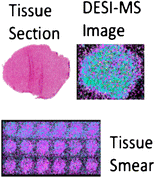An Assessment of the Utility of Tissue Smears in Rapid Cancer Profiling with Desorption Electrospray Ionization Mass Spectrometry (DESI-MS) |
| |
| Authors: | Michael Woolman,Alessandra Tata,Emma Bluemke,Delaram Dara,Howard J. Ginsberg |
| |
| Affiliation: | 1.Techna Institute for the Advancement of Technology for Health,University Health Network,Toronto,Canada;2.Institute of Biomaterials and Biomedical Engineering,University of Toronto,Toronto,Canada;3.Department of Surgery,University of Toronto,Toronto,Canada;4.Keenan Research Center for Biomedical Science,Li Ka Shing Knowledge Institute, St. Michael’s Hospital,Toronto,Canada;5.Department of Medical Biophysics,University of Toronto,Toronto,Canada |
| |
| Abstract: | Mass spectrometry imaging with desorption electrospray ionization mass spectrometry (DESI-MS) is used to characterize cancer from ex vivo slices of tissues. The process is time-consuming. The use of tissue smears for DESI-MS analysis has been proposed as it eliminates the time required to snap-freeze and section the tissue. To assess the utility of tissue smears for rapid cancer characterization, principal component analysis (PCA) was performed to evaluate the concordance between DESI-MS profiles of breast cancer from tissue slices and smears prepared on various surfaces. PCA suggested no statistical discrimination between DESI-MS profiles of tissue sections and tissue smears prepared on glass, polytetrafluoroethylene (PTFE), and porous PTFE. However, the abundances of cancer biomarker ions varied between sections and smears, with DESI-MS analysis of tissue sections yielding higher ion abundances of cancer biomarkers compared with smears. Coefficient of variance (CV) analysis suggests DESI-MS profiles from tissue smears are as reproducible as the ones from tissue sections. The limit of detection with smear samples from single pixel analysis is comparable to tissue sections that average the signal from a tissue area of 0.01 mm2. The smears prepared on the PTFE surface possessed a higher degree of homogeneity compared with the smears prepared on the glass surface. This allowed single MS scans (~1 s) from random positions across the surface of the smear to be used in rapid cancer typing with good reproducibility, providing pathologic information for cancer typing at speeds suitable for clinical utility. |
| |
| Keywords: | |
| 本文献已被 SpringerLink 等数据库收录! |
|

